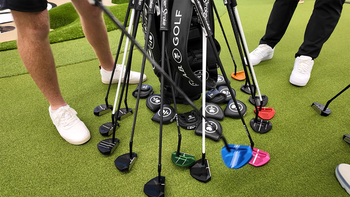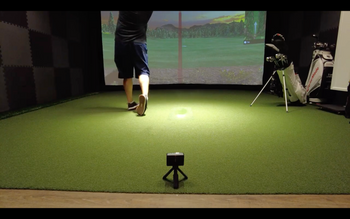Golf simulators and launch monitors help improve your game in different ways. You'll get immersive virtual course experiences with interactive gameplay from simulators, but they'll need more space and a bigger investment ($5,000-$100,000+). Launch monitors are more focused - they'll show you detailed shot data and help you analyze your swing mechanics. They're portable and won't break the bank ($500-$20,000). Both tools give you accurate measurements, but they serve different purposes. Simulators create a complete virtual environment, while launch monitors excel at technical analysis. When choosing between the two, think about what you're trying to achieve, how much space you have, and what you can spend.
Understanding the Core Differences
Choosing between a golf simulator and launch monitor? Let's break it down. While they both track your shots, they're quite different tools that serve different purposes.
Think of a launch monitor as your data-driven practice partner - it spits out all the important numbers for each shot, making it perfect for practice sessions at the range or in your yard. A simulator is more like having your own virtual golf club, letting you play famous courses without leaving home.
You'll need a decent amount of space to set up a simulator, plus extra gear to make it work. But once it's ready, you're set for an incredibly realistic round of golf right from your garage. Launch monitors are all about the technical stuff - they'll show you launch angles and backspin data that's super helpful for fixing your technique.
The big difference? Launch monitors are portable and straightforward, while simulators are like having a complete golf paradise at home. Price is often the deal-breaker - good simulators can cost anywhere from $5,000 to $70,000 more than basic launch monitors. So your budget might make the choice pretty clear.
Key Features and Capabilities
Although both devices track your golf shots, golf simulators and launch monitors pack distinct features that set them apart in meaningful ways. You'll find simulators offer an immersive experience with high-definition virtual environments, while launch monitors focus on providing precise numerical data for your game analysis.
With a simulator, you'll enjoy interactive features like multiplayer modes and virtual course play, powered by sophisticated cameras and sensors. They'll show you everything from club speed to ball spin in a visually engaging format. Launch monitors, on the other hand, are more efficient - they'll give you detailed stats about your swing mechanics and ball flight through Doppler radar or high-speed cameras. Launch monitors are highly portable and can be easily used at different locations. If you're tech-savvy, you'll appreciate that many launch monitors now connect to your smartphone for improved analysis. Modern simulators use complex algorithms to calculate factors like wind conditions and elevation changes for ultra-realistic gameplay.
Space and Setup Requirements
The physical demands of golf simulators and launch monitors extend far beyond their technical capabilities. You'll need to weigh both height and width carefully, as your space requirements will differ depending on your choice. For a golf simulator, you're looking at a minimum room size of 12 feet long, 10 feet wide, and 8.5 feet high, though ideal setups need more space. Many golfers find that spare rooms or garages provide the perfect environment for their setup. Today's advanced monitors offer real-time feedback to enhance your practice sessions, making the space investment worthwhile.
Launch monitors can be more flexible with space, especially if you're using a photometric model that sits beside your hitting area. If you've got a radar-based monitor, though, you'll need extra room behind you - typically 6-10 feet. Remember, whatever option you choose, you'll want enough ceiling clearance for your full swing, which means at least 9 feet of height for most golfers.
Performance Analysis and Data Output
Since tracking your performance data makes all the difference in improving your game, you'll find significant distinctions between simulators and launch monitors. Launch monitors excel at providing precise numerical data, measuring everything from ball speed to spin rate with impressive accuracy - we're talking variances as low as 0.19% in some cases. The Bushnell Launch Pro stands out with its remarkable total deviation of 1.14% for indoor tracking performance. The Foresight GCQuad demonstrated superior consistency with +/- 3.2 yards across all club testing.
Simulators take this raw data and convert it into a more digestible visual experience. While a launch monitor might tell you your ball speed is 150 mph with a 2.82% backspin variance, a simulator shows you exactly how that translates to ball flight on screen. You'll get the same accurate measurements either way, but simulators make it easier to understand how the numbers affect your actual game through immediate visual feedback and shot tracking.
Cost Comparison and Value Assessment
Making smart choices about performance tracking tools becomes even more crucial when you consider their price tags. You'll find launch monitors ranging from $500 to over $20,000, while golf simulators often demand an even heftier investment, especially at the premium end. A simulator like GOLFZON offers players access to over 200 courses for their virtual golfing experience.
If you're budget-conscious, you might want to start with a launch monitor like the Swing Caddie SC4 Pro at $599, which offers solid features without breaking the bank. The device's built-in screen display makes it particularly convenient for quick data checks during practice sessions. While simulators require more space and initial investment, they'll give you that immersive experience you can't get from a launch monitor alone. Remember to factor in ongoing costs too - some launch monitors need subscription fees, while simulators might require additional accessories and higher energy costs. The good news? High-end equipment tends to hold its value well over time.
Making the Right Choice for Your Needs
Deciding between a launch monitor and golf simulator requires careful consideration of your specific goals, budget, and available space. When making your choice, you'll want to evaluate how you plan to use the equipment and what features matter most to your game improvement experience.
Here's what you should consider when making your decision:
If you're focused purely on swing metrics and practice efficiency, a launch monitor's portability might be your best bet
If you crave an immersive experience with virtual courses, a simulator's extensive features will serve you better
Consider your available space - launch monitors need minimal room while simulators require dedicated areas
Think about setup time - launch monitors offer quick, hassle-free sessions
Factor in your practice style - casual sessions favor launch monitors, while longer practices benefit from simulators
Frequently Asked Questions
Can Golf Simulators and Launch Monitors Be Used in Direct Sunlight?
You'll get better results avoiding direct sunlight with both devices. If you must use them outside, you'll need shading solutions like umbrellas or blackout curtains for accurate readings.
How Long Do Batteries Typically Last in Portable Launch Monitors?
You'll get varying battery life in portable launch monitors - typically 5-20 hours per charge. The Voice Caddie SC300i leads with 20 hours, while SkyTrak offers around 5 hours of use.
Are Golf Simulators and Launch Monitors Legal for Tournament Play Practice?
You're in luck - tournament officials won't slap handcuffs on you for practicing with these gadgets! Launch monitors and simulators are perfectly legal for pre-tournament preparation and practice sessions.
Can Left-Handed Golfers Use All Types of Launch Monitors?
You'll find most launch monitors work for left-handed golfers, though some models require repositioning. Radar-based systems offer seamless shifts, while camera-based units may need recalibration for left-handed play.
Do Weather Conditions Affect the Accuracy of Launch Monitor Readings?
Hit the nail on the head - weather conditions affect your launch monitor's accuracy. Wind, rain, and bright sunlight can mess up your readings, especially with Doppler radar-based monitors outdoors.
Conclusion
When choosing between a golf simulator and launch monitor, you'll need to weigh your goals like a golfer selecting the perfect club for an essential shot. If you're looking for all-encompassing entertainment and year-round practice, a simulator's your best bet. But if you're focused on improving specific aspects of your game and want portability, a launch monitor will serve you well while keeping more cash in your pocket.







